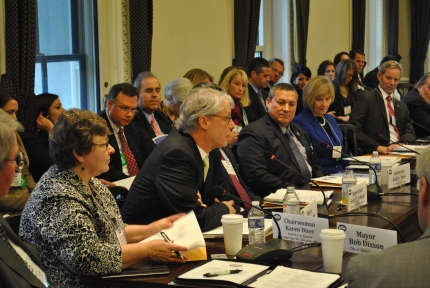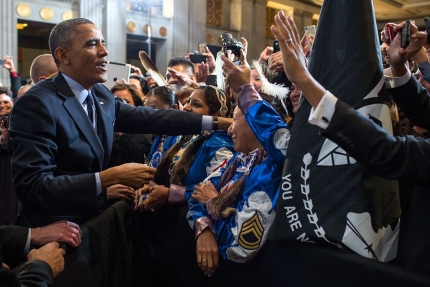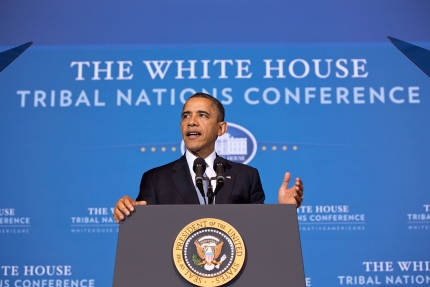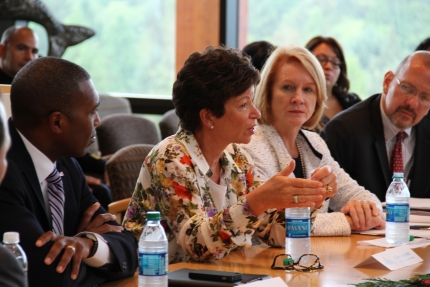Blog Posts Related to the Native American Community
Moving Forward to Protect Native American Women: Justice Department Announces VAWA 2013 Pilot Project for Tribes
Posted by on February 6, 2014 at 1:38 PM EDTToday, we are excited to announce a key step that will help protect Native American women from domestic violence. Last year, President Obama signed the reauthorization of the Violence Against Women Act (VAWA) recognizing a tribe’s inherent right to protect women previously left vulnerable by gaps in the law. Today, the Attorney General announced that three American Indian tribes – the Confederated Tribes of the Umatilla Indian Reservation of Oregon, the Pascua Yaqui Tribe of Arizona, and the Tulalip Tribes of Washington –will participate in the Department of Justice’s (DOJ) Pilot Project to implement the new law. Crimes of domestic violence committed on the reservations of these tribes will be subject to tribal criminal prosecution, regardless of the defendant’s status as an Indian or non-Indian. The Pilot Projects are vital to delivering justice for Native American women who are victims of domestic violence and to providing a safer and more secure Indian Country.
Improving the safety of our tribal communities is a priority of President Obama and his Administration, including recognizing and strengthening tribal sovereignty. A recent study by the Centers for Disease Control and Prevention found that 46% of Native American women have experienced rape, physical violence, and/or stalking by an intimate partner in their lifetime. Senior Advisor to the President Valerie Jarrett highlighted the issue of domestic violence in Indian Country when she traveled to the Tulalip Tribes of Washington last year and spent time with tribal criminal justice leaders engaged in ending violence against Native women. Along with the Pilot Projects, the 2013 reauthorization of VAWA also clarifies that tribal courts have full civil jurisdiction to provide Native American women the safety and security of protection orders. And the new law gives additional tools to federal prosecutors to combat severe cases of domestic violence. These important provisions remind us all that a victim is a victim, and that everyone is entitled to protection against any perpetrator.
VAWA builds upon the foundation of the Tribal Law and Order Act (TLOA), which recently marked its third anniversary and continues to strengthen tribal sovereignty through more effective tribal justice systems. Today, the participating tribes in the Pilot Project can ensure that justice is served on their own lands, stop the cycle of violence against women, and help fulfill President Obama’s larger agenda to make Indian Country a safer, more prosperous place for Native Americans. Tribal participation in these Pilot Projects is crucial in building a better criminal justice system, bolstering tribal control and authority, and ultimately saving the lives of Native American women.
More information about today’s announcement can be found on the Department of Justice’s Tribal Justice and Safety Web site, available at: www.justice.gov/tribal.
Lynn Rosenthal is the White House Advisor on Violence Against Women; Jodi Gillette is the Senior Advisor for Native American Affairs in the White House Domestic Policy Council; and Raina Thiele is an Associate Director in the White House Office of Intergovernmental Affairs.
Learn more about WomenNarrowing the Digital Divide in the Navajo Nation
Posted by on January 8, 2014 at 1:28 PM EDTEd. Note: This blog is cross-posted from the U.S. Department of Commerce.
Spread across the Four Corners region of the American Southwest, the Navajo Nation is home to up to 175,000 members of the Navajo Tribe. Tribal members live scattered across more than 27,000 square miles of land stretching from northeast Arizona to northwest New Mexico to southeast Utah.
It’s a place where many roads have never been paved, many buildings don’t have a formal postal address and thousands of families remain cut off from the electrical grid. At least 60 percent of homes don’t have landline telephone service even though wireless signals are often spotty or nonexistent. The 911 system often cannot track where people are calling from during an emergency. And high-speed Internet access has been almost entirely unavailable.
Data from the National Broadband Map, which is maintained by NTIA in collaboration with the Federal Communications Commission, show that less than 4 percent of the population living in Navajo Nation territory has access to even the most basic wireline broadband speeds of 3 megabits per second downstream.
But with a $32 million grant from NTIA’s Broadband Technology Opportunities Program (BTOP), the Navajo Tribal Utility Authority is bringing a modern wireless communications system to a region that has been all too frequently bypassed by amenities that most Americans take for granted.
Established in 1959 to deliver basic utility services, the Navajo Tribal Utility Authority today is one of the largest utilities owned and operated by an American Indian tribe. It provides water, sewage, electricity, natural gas, solar power and communications services to tens of thousands of customers across the Navajo Nation. And now the Navajo Tribal Utility Authority is signing up its first customers for a new 4G LTE wireless broadband network funded largely by the federal government.
Covering 15,000 square miles, the new network consists of 59 wireless towers, 43 base stations, 60 microwave links, 550 miles of fiber and 20 miles of fiber or microwave connections into buildings. BTOP paid for much of that infrastructure, as well as a leased fiber-optic connection that runs 180 miles from the edge of the Navajo Nation in Farmington, N.M., to Albuquerque - linking the entire system to the Internet.
Working with wireless partner Commnet, the Navajo Tribal Utility Authority is offering wireless voice and data services for residential customers at speeds of up to three megabits per second. Customers can sign up for mobile access, as well as a fixed-wireless service that plugs into a home computer. The utility is also connecting local schools, hospitals and other anchor institutions, including 49 tribal “chapter houses,” at speeds of up to 10 gigabits per second.
Walter Haase, general manager of the Navajo Tribal Utility Authority, says the wireless broadband network “opens up a whole new set of opportunities that don’t exist today” for the Navajo Nation. Medical specialists located on Navajo territory and beyond will be able to consult electronically with patients living in remote corners of the region. Local schools will be able to live stream Web video and other educational resources from the Internet to supplement the existing curriculum. College students will be able to take online classes and connect with professors at major universities without leaving their ancestral homeland. And tribal members will be able to set up online businesses or telework instead of having to travel long distances to get to a job.
Eventually, Haase says, the Navajo Tribal Utility Authority hopes to interconnect the wireless broadband network with smart grid meters serving its residential electricity customers in order to set up a 911 system that will know automatically where someone is calling from in an emergency.
Altogether, NTIA’s Broadband Technology Opportunities Program has invested in more than 50 projects that are benefiting tribes by building networks in parts of Indian Country that have historically lacked adequate telecommunications infrastructure. NTIA has also funded public computer centers, digital literacy classes and one-on-one Internet training programs in a number of Native American communities.
Some of the federal awards went directly to tribes themselves, including the Ute Indian Tribe in Utah, the Nez Perce Tribe in Idaho, the Pyramid Lake Paiute Tribe in Nevada and the Saint Regis Mohawk Tribe in Upstate New York. Others went to tribal institutions such as the College of Menominee Nation in Wisconsin and, of course, the Navajo Tribal Utility Authority.
The push to close the digital divide in Indian Country – which includes some of the most remote reaches of the nation - is no easy task. National Broadband Map data show that only 54 percent of the population in Indian Country has access to basic wireline broadband speeds of 3 megabits per second downstream. That compares with 94 percent of the U.S. population as a whole. And only half of Indian Country population has access to 6-megabit wireless speeds, compared with 91 percent of the population as a whole.
But with support from the Broadband Technology Opportunities Program, these federally funded projects are helping to narrow the gap and ensure that tribal communities can share in the benefits and opportunities brought by the Internet.
Jean Rice is a NTIA Program Officer at the Department of Commerce
Learn more about TechnologyInterior's Land Buy-Back Program: Strengthening our Nation-to-Nation Partnership
Posted by on December 20, 2013 at 12:06 PM EDTEd. Note: This blog is cross-posted from the U.S. Department of the Interior.
Last year, the Department of the Interior established the Land Buy-Back Program for Tribal Nations to implement important land consolidation requirements set forth in the historic Cobell Settlement Agreement. That agreement provided for a $1.9 billion fund to consolidate lands that have become fractionated, over time, across Indian Country. By establishing the Buy-Back Program, the Department made a commitment to work together – with tribes and individual Indian land owners alike– to address the negative impacts of land fractionation in Indian Country.
Fractionation of ownership affects more than 93,500 land tracts on more than 150 Indian reservations. These tracts often have hundreds, sometimes thousands, of owners that must each be consulted before even basic decisions can be made about use of land and resources.
Over the next 10 years, the Buy-Back Program will make purchase offers to willing sellers in an effort to make land more usable and prevent further fractionation. By doing this, Interior will help expand tribal economic development opportunities across Indian Country, and, in turn, restore tribal control over tribal lands and resources in order to build towards true tribal self-determination and ultimately strengthened tribal sovereignty.
In our first year, the Department has focused on establishing the building blocks of program success. Nation-to-Nation conversations have been critical to this development, and have helped us make significant policy decisions about the Program. This past month, we released an Updated Implementation Plan, which incorporates suggestions and responds to comments received through multiple tribal consultations and one-on-one meetings.
We have heard from tribal leaders that we must implement the Buy-Back Program in a fair and equitable manner, moving quickly to ensure that we reach as much of Indian Country as possible. Additionally, we sought independent analysis from The Appraisal Foundation, the nation’s foremost authority on appraisal standards to ensure a high quality valuation process would be used.
Tribes also expressed the need for predictability and transparency on the timing of implementation efforts. In response, the Department expanded its implementation strategy by opening up a solicitation period through March 2014, during which tribes with jurisdiction over the most fractionated locations are invited to submit letters of interest or cooperative agreement applications for participation in the program. This solicitation puts much of the timing in the hands of tribal governments and will allow the program to move on a quicker timeline.
And, in a historic step this week, Interior announced that the very first purchase offers have been sent. After working closely with Oglala Sioux leadership, landowners on the Pine Ridge Reservation – one of the most fractionated locations in the United States – will be receiving purchase offers this week. Individuals with interests at the Makah Indian Reservation will receive offers as well.
We know the challenge ahead is mighty, but we are working hard to ensure that this incredible opportunity for Indian Country is not wasted. Change will not be implemented overnight, but ultimately the Program will restore lands to tribes and place decision-making over these lands back into the rightful hands of tribal governments. Our Nation-to Nation partnerships have been critical to the work that has gotten us to today and we look forward to our continued work together.
Kevin K. Washburn is the Assistant Secretary for Indian Affairs at the Department of the Interior and a member of the Chickasaw Nation in Oklahoma.
Task Force on Climate Preparedness and Resilience Hosts Inaugural Meeting
Posted by on December 16, 2013 at 6:00 PM EDTLast week, members of the State, Local and Tribal Leaders Task Force on Climate Preparedness and Resilience participated in their inaugural meeting at the White House. President Obama created this Task Force in his Climate Action Plan to advise the Administration on how the Federal government can support communities across the country that are dealing with the impacts of climate change. In 2012 alone, the costs of weather disasters exceeded $110 billion in the United States – including the terrible destruction caused by Hurricane Sandy. Climate change is increasing the frequency and intensity of these kinds of events – as well as the costs and public health impacts associated with them.
From Alabama to Guam, from Los Angeles to Philadelphia, state, local, and tribal leaders are on the front lines of dealing with extreme weather, sea level rise, and other impacts of climate change. This diverse group of elected officials brought their expertise and experience in building community resilience to our first meeting. Task Force members discussed ways to improve coordination to protect critical infrastructure, public resources, and emphasize pre-disaster preparedness. They also shared ideas about the types of information and tools that would be most useful in confronting the impacts of climate change.
Learn more about Energy and Environment2013 White House Tribal Nations Conference: Promoting Prosperous, Resilient Tribal Nations
Posted by on November 14, 2013 at 6:09 PM EDTEd. note: This is cross-posted from the Department of the Interior. See the original post here.
Yesterday I had the tremendous honor of welcoming leaders invited from all 566 federally recognized tribes to the 2013 White House Tribal Nations Conference. The event included participation from President Obama, thirteen Cabinet members, and dozens of senior Administration officials.
The White House Tribal National Conference – the fifth of the Obama Administration – is an opportunity to connect tribal leaders across the country directly with President Obama and his Administration as we work together toward tribal self-determination and self-governance. In his remarks, the President said, “That’s what we’re called to do – to keep strong the covenant between us – for this and future generations.”
President Obama Meets with Tribal Leaders Ahead of the White House Tribal Nations Conference
Posted by on November 12, 2013 at 5:35 PM EDTAhead of his remarks at tomorrow’s White House Tribal Nations Conference, President Obama met today with a dozen tribal leaders to discuss job creation and economic development in tribal communities. Also participating in the meeting were Secretary of the Interior Sally Jewell, Senior Advisor to the President Valerie Jarrett, White House Domestic Policy Council Director Cecilia Muñoz, Director of the National Economic Council Gene Sperling and Director of the Office of Intergovernmental Affairs David Agnew.
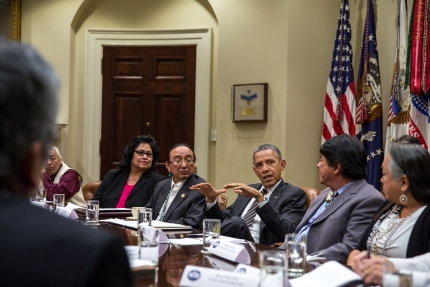
President Barack Obama meets with a group of tribal leaders in the Roosevelt Room of the White House, Nov. 12, 2013. (Official White House Photo by Pete Souza)
This meeting provided tribal leaders an opportunity to directly engage with the President on a leader-to-leader, government-to-government basis and to discuss key issues facing Indian Country at the highest level of Government. During the meeting, tribal leaders in attendance raised a wide range of important issues they are facing related to job creation, including expanding opportunity for renewable energy on tribal lands, increasing access to capital and foreign direct investment opportunities in Indian Country, the successes of tribal self-determination, improving educational outcomes, and jurisdictional challenges.
The twelve tribal leaders that participated in the meeting were:
- Bill Anoatubby, Governor, Chickasaw Nation of Oklahoma
- Melanie Benjamin, Chief Executive, Mille Lacs Band of Ojibwe of Minnesota
- Leonard Forsman, Chairman, Suquamish Tribe of Washington
- Joe Garcia, Governor, Ohkay Owingeh of New Mexico
- Ray Halibritter, Nation Representative and CEO, Oneida Indian Nations of New York
- Carole Lankford, Vice Chairwoman, Confederated Salish and Kootenai Tribes of Montana
- Rex Lee Jim, Vice President, Navajo Nation of Arizona, New Mexico and Utah
- Chris McNeil, CEO, Sealaska of Alaska
- Rosemary Morillo, Chairwoman, Soboba Band of Luiseño Indians of California
- Terri Parton, President, Wichita and Affiliated Tribes of Oklahoma
- Terry Rambler, Chairman, San Carlos Apache Tribe of Arizona
- Robert Shepherd, Chairman, Sisseton-Wahpeton Oyate of South Dakota
Today's meeting kicked off a week of events hosted by the White House Council on Native American Affairs in its continued efforts to strengthen the government-to-government relationship between the United States and Tribal Nations. Tomorrow, the President will host tribal leaders invited from all 566 federally recognized tribes at the fifth consecutive White House Tribal Nations Conference, where tribal leaders will engage with the President, members of his Cabinet and other Senior Administration Officials. The membership of The White House Council on Native American Affairs is also hosting several other meetings and listening sessions to coincide with the Tribal Nations Conference.
Charlie Galbraith is an Associate Director in the Office of Intergovernmental Affairs and Public Engagement. Jodi Gillette is Senior Policy Advisor for Native American Affairs at the White House Domestic Policy Council.
President Obama to Host the 2013 White House Tribal Nations Conference
Posted by on November 12, 2013 at 12:21 PM EDTTomorrow, President Obama will host representatives invited from 566 American Indian and Alaska Native tribes at the 2013 White House Tribal Nations Conference. This year marks the 5th Conference and reinforces our commitment to a strong government-to-government relationship with Tribal Leadership.
Earlier this year, the President established the White House Council on Native American Affairs to promote and sustain prosperous and resilient Tribal nations. Chair of this Council, Secretary Jewell of the Department of the Interior, will lead several Cabinet officials in direct discussions with tribal leaders during the Conference.
You can watch the morning and afternoon sessions of the 2013 White House Tribal Nations Conference by tuning in at www.DOI.gov/live.
The agenda is as follows:
Morning Session, 9:00am – 11:30am EST
- Secretary Sally Jewell, Department of the Interior
- Secretary Eric Shinseki, Department of Veterans Affairs
- Secretary Kathleen Sebelius, Department of Health and Human Services
- Secretary Anthony Foxx, Department of Transportation
- Secretary Ernest Moniz, Department of Energy
- Attorney General Eric Holder, Department of Justice
Afternoon Session, 2:00pm – 4:00pm EST
- Administrator Gina McCarthy, Environmental Protection Agency
- Secretary Thomas Perez, Department of Labor
- Secretary Tom Vilsack, Department of Agriculture
Listening Session of the White House Council on Native American Affairs:
- Secretary Sally Jewell, Department of the Interior (Chair and Co-Moderator)
- Cecilia Muñoz, Assistant to the President and Director of the White House Domestic Policy Council (Co-Moderator)
- Secretary Tom Vilsack, Department of Agriculture
- Secretary Thomas Perez, Department of Labor
- Secretary Shaun Donovan, Department of Housing and Urban Development
- Secretary Arne Duncan, Department of Education
- Acting Secretary Rand Beers, Department of Homeland Security
- Administrator Gina McCarthy, Environmental Protection Agency
- Acting Administrator Jeanne Hulit, Small Business Administration
- Chair Nancy Sutley, Council on Environmental Quality
President Barack Obama

Audience members listen as President Barack Obama delivers remarks during the White House Tribal Nations Conference at the Department of the Interior in Washington, D.C., Dec. 5, 2012. (Official White House Photo by Pete Souza)
We hope you will join us.
Charlie Gailbraith is an Associate Director of Intergovernmental Affairs, and Jodi Gillette is a Senior Policy Advisor for the Domestic Policy Council.
Health, Innovation and the Promise of VAWA 2013 in Indian Country
Posted by on September 6, 2013 at 6:30 PM EDTYesterday morning, we made our way north from Seattle, past gorgeous waterways, and lush greenery to visit with the Tulalip tribes of western Washington, where we were greeted by Tribal Chairman Mel Sheldon, Vice Chairwoman Deb Parker, and Chief Judge Theresa Pouley. We saw first-hand, a tribal court system which serves to both honor the traditions of its people and to foster a renewed era of tribal self-determination.
The Tulalip Tribes of Washington, like many American Indian tribes, have built a tribal court system that serves the civil needs of their community, holds criminals accountable, and protects the rights of victims and the accused in criminal cases. By engaging the entire spectrum of stakeholders, including judges, the police, public defenders, tribal attorneys, as well as tribal elders, and even offenders in many cases– the system they have put in place is producing impressive results with a unique focus on innovative, restorative, and communal solutions.
Because of the successful 2013 Reauthorization of the Violence Against Women Act, which President Obama signed into law on March 7, 2013, tribal courts and law enforcement will soon be able to exercise the sovereign power to investigate, prosecute, convict, and sentence those who commit acts of domestic violence or dating violence or violate certain protection orders in Indian country, regardless of the defendant’s Indian or non-Indian status. The tribal provisions of this landmark legislation were originally proposed by the Department of Justice in 2011 to address alarming rates of violence against native women. We believe today, as we did then, that this is not only constitutionally sound law, but it is also a moral prerogative and an essential tool to ensure that non-Indian men who assault Indian women are held accountable for their crimes.
The 2013 VAWA reauthorization might never have happened without the relentless efforts of native women advocates like Tulalip Tribal Vice Chairwoman Deborah Parker, whose personal courage and dedication to this cause helped carry the day. The Tulalip Tribe was but one example that helped demonstrate to Congress and many others that there are tribal courts prepared to exercise this important authority that was swept away by the Supreme Court’s 1978 Oliphant ruling.
This new law generally takes effect on March 7, 2015, but also authorizes a voluntary pilot project to allow certain tribes to begin exercising this authority sooner.
After a visit to the Tribal Courthouse, we then visited the Tulalip Legacy of Healing Safe House, a domestic violence shelter housed in facilities renovated with federal Recovery Act funds, to provide victims a safe place, and the chance they need to start fresh and rebuild.
And finally, it wouldn’t have been an authentic trip to Tulalip lands and the Pacific Northwest without a traditional salmon luncheon. We joined around 50 tribal members at the Hibulb Cultural Center to learn more about the ancient tribal traditions of the Tulalip people, and of course, to enjoy the region’s most time-honored and delicious delicacy.
We were reminded this week of how much progress is being made by tribal justice systems across the country. These efforts are being led by courageous native people like the Tulalip who are dedicated to making the promise of the VAWA 2013 Reauthorization into a reality for generations of Native American women.
Valerie Jarrett is the Senior Advisor to the President and Tony West is the U.S. Associate Attorney General
Learn more about
- &lsaquo previous
- 1
- 2
- 3
- 4
- 5
- 6
- 7
- 8
- 9
- …
- next &rsaquo
